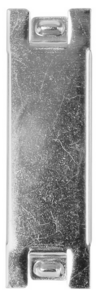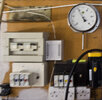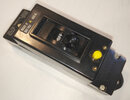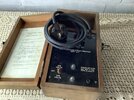client sees is C2s to be done, C3s to be ignored
You make a good point, maybe we should drop the coding? List as faults needing correction?
Generally C1s won't exist on the report
I also agree with that, although the lock out devices

at £1 a piece one can afford to lose, but some

can cost £12 each, it depends on the make of the MCB/RCBO to which will fit. It was all well and good on commercial premises where you know they will return to the electricians quarantine lockup, but not when you may never see them again.
The big problem I found was missing blanks with consumer units, or blanks which can be removed without a tool. This

stuff can often be removed with a finger nail, i.e. does not require a tool or key, this

however you need to remove the cover to fit them, and are OK, the other stuff is OK then the consumer units lid is locked shut. At 77p each not expensive, but I have from time to time run out of them.
Be it replace a socket, or fit a blank, it is like the MOT station replacing a bulb, some will do it FOC and get a good name as a result, others will fail the car and you have to pay for the repair, or for a retest if you remove the vehicle when the garage it was tested at could have repaired it.
As to the old Wylex fuse box,

there would be no point locking off these MCB's as they could be withdrawn and replaced without a tool. The cover in case show is missing, cutting the hole for MCB's was not easy without the bakelite smashing, if it had the thumb screw then still no good, only with a slot headed screw would it comply. As to the RCD's shown feeding the two fuse boxes, I don't think I ever had a lock off device for those, they were fitted around 1992 at that time getting a consumer unit with RCD protection built in was hard, the

ELCB-v was still around, I know they were withdrawn, and I would be unable to test them as these

test sets only found in museums. But again how would you lock it off? Your not permitted to draw the DNO fuse, and even if you did, it can be replaced without use of a tool.
I was surprised that the HGV MOT station could not stop one taking a vehicle off the premises when found dangerous, they had to get the police to stop you after you left the MOT station and then they could issue a GV9 which means you would need to get a low loader or tow truck to remove it. So one would be daft to try driving it out of the station.
So as to an EICR you need permission to turn off the supply to test it, once turned off you can't reinstate if it attracts code C1, what is not so clear, with domestic, (with commercial the EAW act comes in) can you leave it without locking off. With domestic if the premises are not habitable then you must find alternative accommodation, however not seen anything about who must pay for it? I am not even sure what is required to make premises habitable, I would assume heating, hot water, and dry and lighting, but with latter would a Tilly lamp be good enough?
I am not qualified as a social worker, and I simply can't understand why there are any homeless in the UK when there are hotel places vacant, I would have thought social services should ensure everyone has a roof over their head, but when one sees all the begging adverts on TV it tends to say this is not the case, we should not need the salvation army in the UK, however it seems we do, so as an electrician doing an EICR we have a balance which we have never been trained to make, fail a property and see homeless people as a result where the landlord says enough is enough and simply sell the property, or pass it with faults which should have had a code C2?
To my mind we simply follow the electrical safety council best practice guide, and try not to force anyone hand, we simply do our job, and no one else's. It is not our job to decide if smoke alarms should be fitted or if the work or are in date, that's the job of the fire safety officer, we with an EICR are there to check the electrical installation, no equipment, we do not need to remove the cover from the boiler and check how it is wired. The only current using items we need to check with an EICR are the lights.








